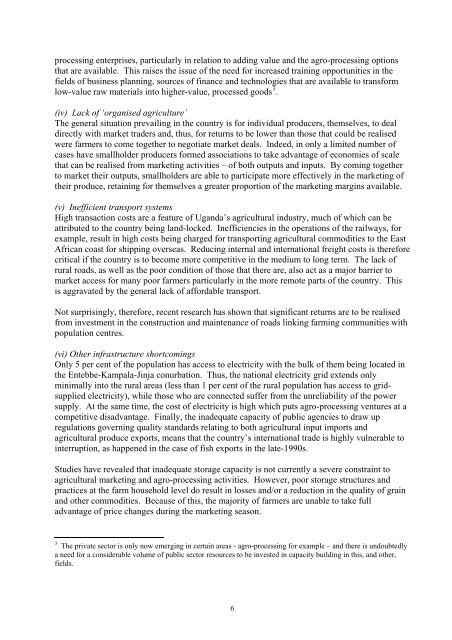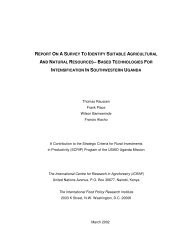Strategy for agricultural marketing and agro-processing ... - Foodnet
Strategy for agricultural marketing and agro-processing ... - Foodnet
Strategy for agricultural marketing and agro-processing ... - Foodnet
You also want an ePaper? Increase the reach of your titles
YUMPU automatically turns print PDFs into web optimized ePapers that Google loves.
<strong>processing</strong> enterprises, particularly in relation to adding value <strong>and</strong> the <strong>agro</strong>-<strong>processing</strong> options<br />
that are available. This raises the issue of the need <strong>for</strong> increased training opportunities in the<br />
fields of business planning, sources of finance <strong>and</strong> technologies that are available to trans<strong>for</strong>m<br />
low-value raw materials into higher-value, processed goods 3 .<br />
(iv) Lack of ‘organised agriculture’<br />
The general situation prevailing in the country is <strong>for</strong> individual producers, themselves, to deal<br />
directly with market traders <strong>and</strong>, thus, <strong>for</strong> returns to be lower than those that could be realised<br />
were farmers to come together to negotiate market deals. Indeed, in only a limited number of<br />
cases have smallholder producers <strong>for</strong>med associations to take advantage of economies of scale<br />
that can be realised from <strong>marketing</strong> activities – of both outputs <strong>and</strong> inputs. By coming together<br />
to market their outputs, smallholders are able to participate more effectively in the <strong>marketing</strong> of<br />
their produce, retaining <strong>for</strong> themselves a greater proportion of the <strong>marketing</strong> margins available.<br />
(v) Inefficient transport systems<br />
High transaction costs are a feature of Ug<strong>and</strong>a’s <strong>agricultural</strong> industry, much of which can be<br />
attributed to the country being l<strong>and</strong>-locked. Inefficiencies in the operations of the railways, <strong>for</strong><br />
example, result in high costs being charged <strong>for</strong> transporting <strong>agricultural</strong> commodities to the East<br />
African coast <strong>for</strong> shipping overseas. Reducing internal <strong>and</strong> international freight costs is there<strong>for</strong>e<br />
critical if the country is to become more competitive in the medium to long term. The lack of<br />
rural roads, as well as the poor condition of those that there are, also act as a major barrier to<br />
market access <strong>for</strong> many poor farmers particularly in the more remote parts of the country. This<br />
is aggravated by the general lack of af<strong>for</strong>dable transport.<br />
Not surprisingly, there<strong>for</strong>e, recent research has shown that significant returns are to be realised<br />
from investment in the construction <strong>and</strong> maintenance of roads linking farming communities with<br />
population centres.<br />
(vi) Other infrastructure shortcomings<br />
Only 5 per cent of the population has access to electricity with the bulk of them being located in<br />
the Entebbe-Kampala-Jinja conurbation. Thus, the national electricity grid extends only<br />
minimally into the rural areas (less than 1 per cent of the rural population has access to gridsupplied<br />
electricity), while those who are connected suffer from the unreliability of the power<br />
supply. At the same time, the cost of electricity is high which puts <strong>agro</strong>-<strong>processing</strong> ventures at a<br />
competitive disadvantage. Finally, the inadequate capacity of public agencies to draw up<br />
regulations governing quality st<strong>and</strong>ards relating to both <strong>agricultural</strong> input imports <strong>and</strong><br />
<strong>agricultural</strong> produce exports, means that the country’s international trade is highly vulnerable to<br />
interruption, as happened in the case of fish exports in the late-1990s.<br />
Studies have revealed that inadequate storage capacity is not currently a severe constraint to<br />
<strong>agricultural</strong> <strong>marketing</strong> <strong>and</strong> <strong>agro</strong>-<strong>processing</strong> activities. However, poor storage structures <strong>and</strong><br />
practices at the farm household level do result in losses <strong>and</strong>/or a reduction in the quality of grain<br />
<strong>and</strong> other commodities. Because of this, the majority of farmers are unable to take full<br />
advantage of price changes during the <strong>marketing</strong> season.<br />
3 The private sector is only now emerging in certain areas - <strong>agro</strong>-<strong>processing</strong> <strong>for</strong> example – <strong>and</strong> there is undoubtedly<br />
a need <strong>for</strong> a considerable volume of public sector resources to be invested in capacity building in this, <strong>and</strong> other,<br />
fields.<br />
6
















